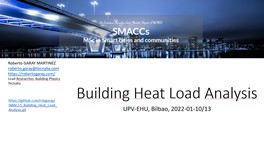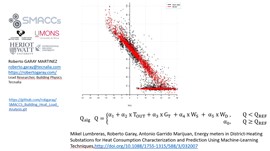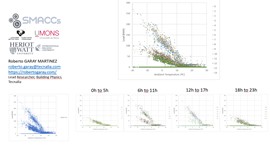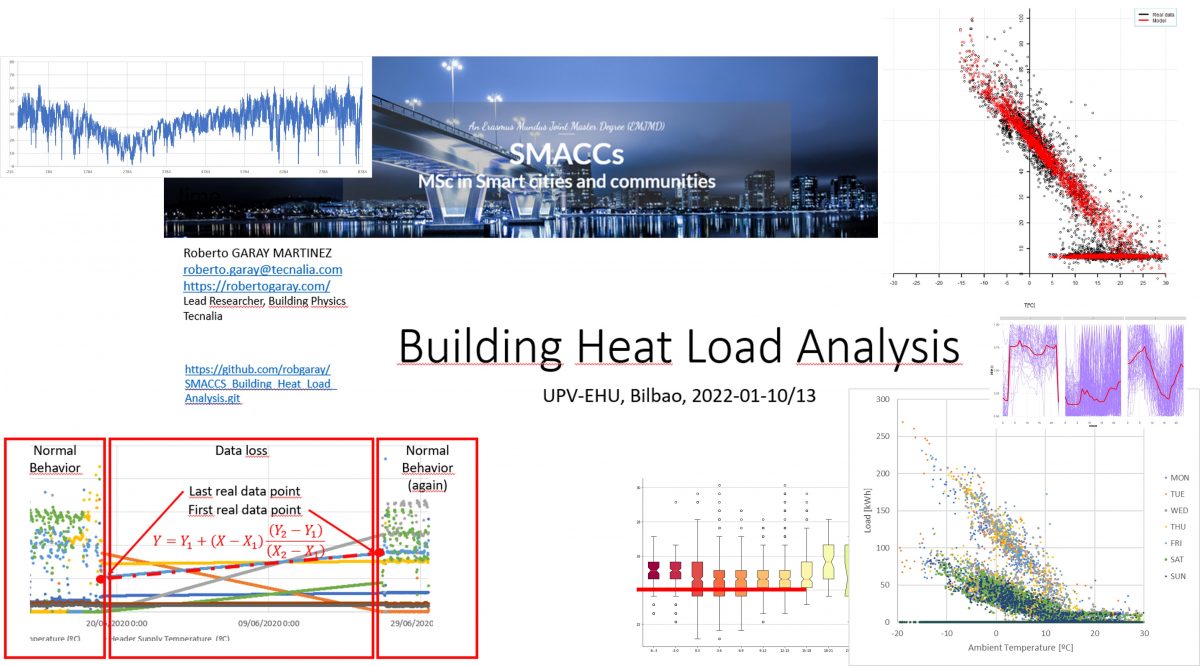I started 2022 taking part in the SMACCs seminar week. SMACCs is a very interesting Erasmus Mundus MsC programme where students get a broad view of sustainability in the built environment. Colleagues from ENEDI (Energy Engineering, University of the Basque Country) are very kind to allow me to deliver seminars every year on various topics.

This year, I delivered an 8-hour seminar on Heat Load Analysis in Buildings. Togethers with other colleagues, I am extremely interested in this topic, which I expect to have an accelerated development with the rollout of Smart meters and IoT connectivity.
I presented an overview of heat loads, user patterns, meters, data quality, analysis methods,… in a condensed way. For those interested, the lecture is available in this GITHUB repository.


Hopefully they will also invite me for next year…
By the way, I would like to acknowledge GREN and BEOELEK for allowing the use of the data gathered within RELaTED to illustrate the analysis methods.
Although my lecture was based on my own work and beliefs, I also took profit of a set of very relevant research works in literature:
- Sicheng Zhan, Zhaoru Liu, Adrian Chong, Da Yan, Building categorization revisited: A clustering-based approach to using smart meter data for building energy benchmarking, Applied Energy, Volume 269, 2020, https://doi.org/10.1016/j.apenergy.2020.114920
- E. Fuentes, L. Arce, J. Salom, A review of domestic hot water consumption profiles for application in systems and buildings energy performance analysis, Renewable and Sustainable Energy Reviews, Volume 81, Part 1, 2018, Pages 1530-1547, ISSN 1364-0321, https://doi.org/10.1016/j.rser.2017.05.229.
- Johra, H., Leiria, D., Heiselberg, P., Marszal-Pomianowska, A., Tvedebrink, T., Treatment and analysis of smart energy meter data from a cluster of buildings connected to district heating: A Danish case (2020) E3S Web of Conferences, 172, art. no. 12004, DOI: 10.1051/e3sconf/202017212004
- Margaret F. Fels, PRISM: An introduction, Energy and Buildings, 1986, https://doi.org/10.1016/0378-7788(86)90003-4
- Kissock, J.K., Jeff S Haberl, and David E. Claridge. 2002. “Development of a Toolkit for Calculating Linear, Change-Point Linear, and Multiple-Linear Inverse Building Energy Analysis Models.”
- Mitchell T. Paulus, David E. Claridge, Charles Culp, Algorithm for automating the selection of a temperature dependent change point model, Energy and Buildings, https://doi.org/10.1016/j.enbuild.2014.11.033
- Xin Liang, Tianzhen Hong, Geoffrey Qiping Shen, Improving the accuracy of energy baseline models for commercial buildings with occupancy data, Applied Energy, https://doi.org/10.1016/j.apenergy.2016.06.141
- Mikel Lumbreras, Roberto Garay, Antonio Garrido Marijuan, Energy meters in District-Heating Substations for Heat Consumption Characterization and Prediction Using Machine-Learning Techniques,http://doi.org/10.1088/1755-1315/588/3/032007
- Mikel Lumbreras, Roberto Garay-Martinez, Beñat Arregi, Koldobika Martin-Escudero, Gonzalo Diarce, Margus Raud, Indrek Hagu, Data driven model for heat load prediction in buildings connected to District Heating by using smart heat meters, Energy, 2022, https://doi.org/10.1016/j.energy.2021.122318
- M. Lumbreras, K. Martin-Escudero, G. Diarce, R. Garay-Martinez and R. Mulero, «Unsupervised Clustering for Pattern Recognition of Heating Energy Demand in Buildings Connected to District-Heating Network,» 2021 6th International Conference on Smart and Sustainable Technologies (SpliTech), 2021, pp. 1-5, doi: https://doi.org/10.23919/SpliTech52315.2021.9566420
- Roberto Garay-Martinez, Beñat Arregi, Mikel Lumbreras, Belén Zurro, Jose Manuel Gonzalez, Jose Luis Hernandez, Data driven process for the energy assessment of building envelope retrofits, NSB2020, Tallinn, 2020. E3S Web of Conferences 172, http://doi.org/10.1051/e3sconf/202017225001
- Beñat Arregi, Roberto Garay, Regression analysis of the energy consumption of tertiary buildings, CISBAT 2017, Lausanne, Switzerland. Energy Procedia, Volume 122, 2017, Pages 9-14, ISSN 1876-6102, https://doi.org/10.1016/j.egypro.2017.07.290.
